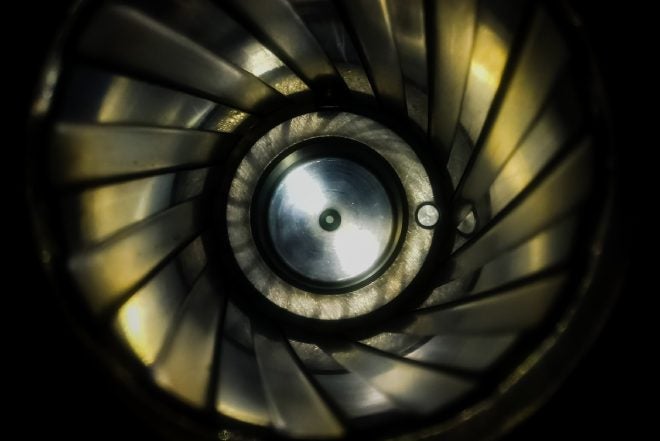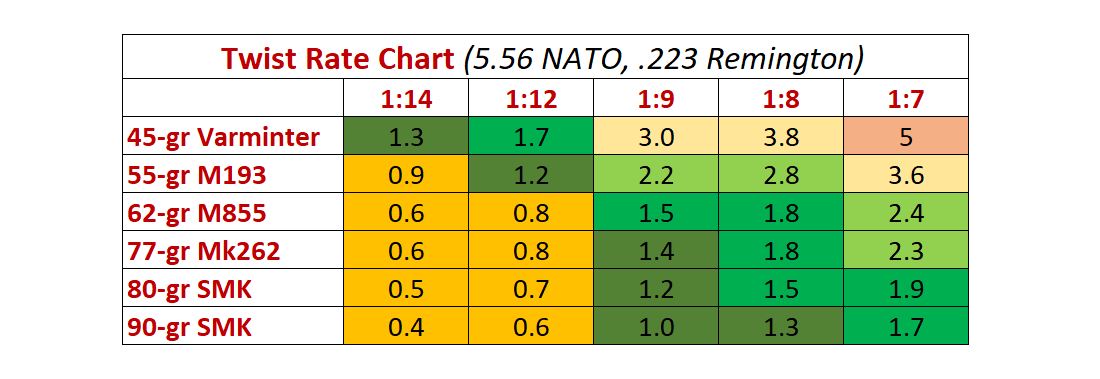Barrel Rifling Twist Rates – Explained
Travis Olander 03.17.23

Twist rate is one of the most important specifications on a modern rifle or pistol. That’s because a firearm’s rifling determines the rounds you’ll shoot, and how accurately those rounds will be in flight.
Picking the perfect twist rate isn’t easy. Most calibers offer different loads, each requiring a particular twist rate to perform optimally. To achieve the most accuracy out of your new long gun or pistol, you need to consider what you’ll use that firearm for, and therefor what loads you’ll chamber most often.
What is Twist Rate?
Twist rate measures of how much the lands and grooves of your barrel’s rifling rotate. The twist of the rifling imparts spin on the bullet as it leaves the muzzle. This gives gyroscopic stability to the round in flight. The concept is no different than the spin a quarterback imparts on a thrown football. All modern rifles and handguns have a twist rate expressed in their barrels’ specifications. Smoothbore guns, like shotguns and some muzzleloaders, have no rifling.
How Twist Rates Are Measured
Twist rate is measured in inches and is expressed as a ratio, written as 1:X, where “X” represents how many inches the rifling travels down the barrel before completing one 360-degree rotation. So, for example, an 18″ barrel with a twist rate of 1:9 would have rifling that completes two full rotations between the chamber and muzzle.
Twist Rate vs. Bullet Weight
Twist rate determines how heavy or light your bullets will be. Bullet weights are advertised as “grain count” or “grain weight”. The higher the grain, the faster the twist rate must be to effectively spin up and stabilize that round before it leaves the barrel.
Twist Rate vs. Barrel Length
Twist rate is not related to barrel length, and barrel length doesn’t affect which twist rate is best for any cartridge. If the cartridge in question performs best with a 1:10 twist rate, that rule always applies, whether it’s fired from a 7.5″ barrel, 16″ barrel, or a 24″ barrel. Barrel length only affects velocity, not the spin of the bullet.
Twist Rate Charts Explained
(Ballistic data courtesy of Everyday Marksman)
This chart describes which twist rates are best for most 5.56 NATO and .223 Remington loads. The numbers in each cell in this graph measure gyroscopic stability factors that each twist rate (top row) provides each 5.56 and .223 load (left column).
Twist Rate and Gyroscopic Stability
Gyroscopic stability describes the tendency for a rotating object to resist changes to its axis of rotation. This rotational stability causes a bullet to resist tumbling and changing direction in flight — gravity notwithstanding. Faster twist rates produce higher gyroscopic stability factors.
Ideal twist rates produce a gyroscopic factor between 1.5 and 2.0.
Factors between 1.0 and 1.3 are marginally stable, but they’re generally considered too slow. Factors between 2.1 and 2.9 are fast, but stable and accurate. Factors above 3.0 are suitable, but not ideal. Climbing above 4.0 may cause over-stabilization of the round being fired, which can harm accuracy. The optimal twist rates for 5.56 and .223 loads are:
- 45-gr Varminter: 1:12 twist
- 55-gr (M193): 1:9 twist
- 62-gr (M855): 1:8 twist
- 77-gr (Mk262): 1:8 twist
- 80-gr Sierra Match: 1:7 twist
- 90-gr Sierra Match: 1:7 twist
What does too much spin do?
The rotation of a bullet directly affects its roll, yaw, and pitch.
- Roll affects the spin of the bullet perpendicular to its travel, like a thrown football.
- Yaw affects the horizontal rotation of the bullet, like a vehicle turning left or right.
- Pitch affects the rise and fall of the bullet, like a plane taking off or landing.
The right amount of spin helps a bullet to resist changes to its yaw and roll, and it helps to stabilize its pitch as the bullet arcs from the barrel to the target. Over-stabilization causes spin drift, which makes the bullet yaw in the direction its spinning. Too much drift will cause a bullet to yaw left or right and ultimately tumble.
Bullet Spin vs. Ballistic Coefficient
Gyroscopic stability correlates directly with a bullet’s ballistic coefficient (BC). BC measures a bullet’s ability to power through air resistance and wind without changing course. The higher the coefficient, the more accuracy is maintained at greater distances. Generally, a round loses 3% of its BC for every 0.1 loss in gyroscopic stability below factors of 1.5.
Other Caliber Twist Rates
300 Blackout Supersonic

Supersonic 300 Blackouts are lightweight .30 caliber loads that earn the most stability in flight from a slow 1:12 twist rate. The typical 1:8 and 1:7 rates used for the AR’s .22-caliber loads will result in an over-stabilized round.
300 Blackout Subsonic
Subsonic 300 BLK is much more forgiving: You can get away with using a 1:10 to 1:7 twist, with 1:8 in the middle being ideal for most loads. Data was not available for 240-grain subsonics, but those heavy rounds benefit most from a 1:7 twist rate.
.308 Winchester, 7.62×51 NATO
Good ole’ .308 Winchester and its NATO sister are consistent performers. Stability remains high across most grain counts and rates, with 1:12 to 1:10 twists being established as the community favorites.
6.5 Creedmoor
Like .308 Win, the 6.5 Creedmoor round is pretty forgiving when it comes to spin. A 1:8 rate is ideal for being able to stabilize most of the 6.5mm’s common loads. If you’re hunting for a pair of antlers, 1:8 also works best for those heavy 155-grain soft points and deer cartridges. Anything between 1:10 and 1:7 will consistently stabilize all but the lightest 120-grain plinkers.
9mm Parabellum
No gyroscopic data chart is needed for 9mm. About a century’s worth of use has formed a consensus for its optimal twist rate. It’s 1:10, always and forever. At this rate of twist, 9mm loads ranging between 90 grains and 147 grains will have favorable gyroscopic stability.
FAQs
Q: Are marginally stable twist rates OK?
A: Yes. Even if you invest in a barrel with a twist rate that yields a gyroscopic stability factor of about 0.8 to 1.4, you can still likely shoot with accuracy. As distance increases, however, stability could falter. You may witness one or two keyhole rounds impacting your target as you approach max effective range of the round you’re shooting. This indicates bullet spin and stability was lost in flight.
Q: What’s a “keyhole” round?
A: A keyhole round is a bullet that impacted its target after it lost spin and stable flight, and began tumbling through the air. The “keyhole” moniker comes from the shape the round makes when it hits the target, resembling that of the keyhole in an old door’s lock.
Q: How do I calculate the ideal twist rate for any bullet?
A: The calculation is called the Miller Formula. The formula requires that you know the following data:
- M: Bullet mass in grains
- S: Gyroscopic stability factor (1.5 is optimal)
- D: Bullet diameter in inches
- L = Length in caliber (bullet length / bullet width)
- The equation is written as Twist Rate = Square Root of (30M / ((S * D * L (1 + L^2)).



